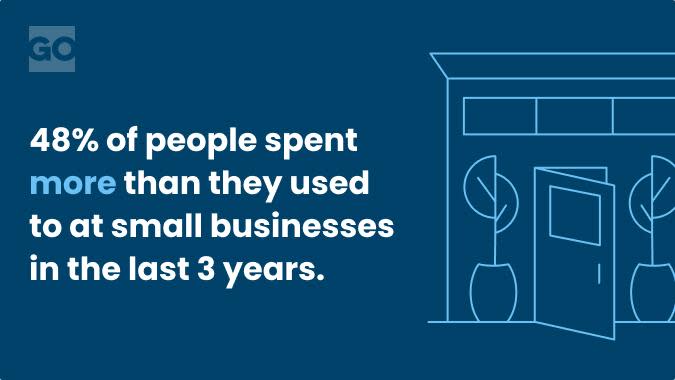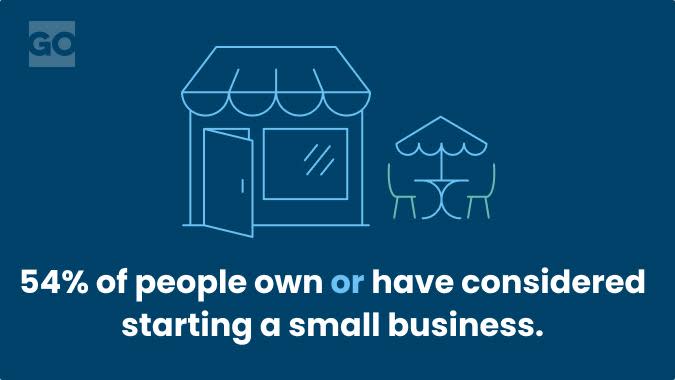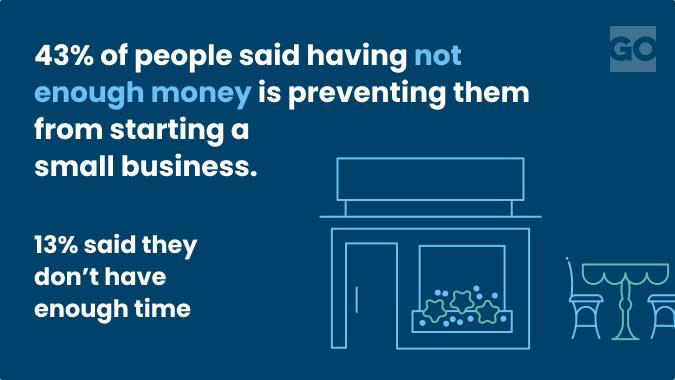The Future of Small Business: Why 48% of Americans Are Spending More at Smaller Shops

Say the word “small business” and it conjures a certain image. Mom-and-pop shops, neighborhood restaurants or boutiques fronted by faces of smiling proprietors who greet their customers by name and sponsor the local little league team. In reality, small businesses fit a far broader profile: They’re retailers, realtors, financial advisors, warehouse owners, tradespeople and much more.
Side Gig: Earn Up To $200/Hour With This Easy-To-Start Job, No College Degree Required
See: How To Get Cash Back on Your Everyday Purchases
In fact, the U.S. Chamber of Commerce defines a small business as one with 500 employees or less, which means mom and pop could be running pretty significant enterprises. By official measures, small businesses employ nearly half the American workforce and represent nearly 44% of America’s GDP.
The COVID-19 pandemic was a sea change moment for small businesses, as different types of consumer needs sparked a wealth of creative solutions and new business opportunities. E-commerce exploded, while many facing job losses turned their hobbies into sources of income, becoming so-called “necessity entrepreneurs”.

Consumers, for their part, have remained steadfast in their loyalty to small businesses. In a recent GOBankingRates survey, more than 80% said they preferred to shop small over major retailers. A majority also said they’re willing to pay more to support small businesses.
The reasons for consumers’ loyalty go back to their sense of human connection. Survey respondents said they prefer small businesses to chains or major retailers because they want to support their communities. They appreciate the customer service they get at a small business. They value relationships that feel more personal.
The Health of Small Businesses
The pandemic at one point seemed to be the death knell of small businesses in America.
At its peak, more than one-third had closed their doors, with minority-owned businesses being hit especially hard. But on the heels of the pandemic, a record-breaking 5.4 million new business applications were filed in 2021, and nearly as many, 5.1 million, were filed in 2022.

Now though, business owners are more optimistic than ever, despite the persistent economic headwinds of inflation, high interest rates and other challenges like hiring and supply chain issues.
“By definition, you sort of have to be optimistic to be a small business owner,” said Richard Bliss, professor of finance at Babson College and national academic director of Goldman Sachs 10,000 Small Businesses. “Sometimes even in the face of reality, they continue to believe that the future is going to be better.”
Bliss believes that small-business growth will remain strong in the years to come but expects it to be more specific to regions and industries. He sees growing future opportunities in the fields with high demand like construction, mental health services, content creation and cybersecurity.
In 2022, the highest number of business applications were for non-store retailers, with people selling goods out of their homes. Close behind in applications were for professional services, followed by construction, according to the U.S. Chamber of Commerce. The biggest spikes in applications came from the states of Wyoming, Mississippi, Michigan and South Carolina, followed by other states across the south.
I’m a Financial Planning Expert: Here Are 3 Ways ChatGPT Can Save You Money
The Rise of the Side Hustle
Many of those sources of alternative income that were borne out of the pandemic are legitimate and thriving businesses today, while side gigs enabled by remote work lifestyles are increasingly normal, especially among Gen Z workers.
A 2022 Accenture PLC survey found that 10% of American professionals had some type of small business on the side and 80% of those intended to keep them permanently.
Nick Loper, founder of the Side Hustle Nation blog and podcast, has seen notable entrepreneurial trends toward home services in particular, driven by demand from a millennial generation of homeowners who are used to having stuff on demand. These include services like lawn care, painting, window cleaning, mobile detailing and power washing. “It’s stuff that maybe isn’t super glamorous but that’s a big area of opportunity with relatively low risk and startup costs,” Loper said.
He expects these opportunities to continue to grow while demand remains high and the number of people going into service-related trades stays relatively low.
Other low-overhead side hustles he sees gaining traction, particularly among younger people, are in content creation. “Video creation, podcasting, social media – there’s this trend toward content creation in general,” he said. “Everyone wants to be a YouTuber or content creator. But on the flip side, it’s got to be good. You have to know how hard it is to make a good video.”
Loper attributes social media in general with fueling this rise in entrepreneurship. “You see everybody else’s highlight reels all day long, and think, ‘well, shoot – if other people could do it, I could too.’ You get a glimpse of what is possible to achieve.”
Earning extra money on the side doing odd jobs is nothing new, he noted. But the entrepreneurial angle of the modern side hustle, which if successful may ultimately be a ticket out of the corporate rat race, has had a particular resonance in the zeitgeist of the Great Resignation and recent challenges of economic necessity.
Financial Challenges
The economic realities facing small businesses still demand extra grit and resilience from owners and will continue to as long as credit stays tight, interest rates stay elevated, costs run higher and consumers pull back on their spending.
In a recent Chamber of Commerce poll, inflation was the top concern among a majority of business owners, who find themselves faced with tough choices between cutting costs, sacrificing quality or employees, and passing their increased costs on to consumers they hope will keep paying.
The majority of the pandemic-period assistance such as SBA loans has dried up. If they hope to grow their businesses, most owners primarily tap into their personal savings or credit cards for funding. They often also turn to community banks or credit unions for financing, though lines of credit are tighter and loans are more expensive to repay.

For minority business owners, however, who have traditionally had even less access to capital than their white counterparts, Bliss sees signs of future hope as many new programs run by NGOs, governments and corporations are rising up to help support them.
A Goldman Sachs program called 1 Million Black Women is providing $10 billion in direct investment capital to black women to address the racial wealth gap. Similarly, JP Morgan made a recent commitment of $30 billion toward driving inclusive growth.
Another organization, New Majority Capital, is connecting the dots between a generation of aging small-business owners wanting to retire and underrepresented would-be entrepreneurs. Where these retirees lack a next generation to carry the torch and keep their businesses open in their communities, the Rhode Island-based organization connects them to a pipeline of entrepreneurs it supports through training and low-risk capital, helping them buy the business and keep it in the community.
“I’m optimistic that when folks – regardless of their backgrounds or wealth – are given the right opportunities and support, that it will have a huge positive impact,” Bliss said.
People Challenges
Another major challenge is hiring the people needed to help a small business run. Nearly half of small businesses across industries surveyed by the National Federation of Independent Businesses reported in June that they were having trouble filling open jobs.
In the construction industry, although demand for building is high, the workforce isn’t there to build things like much-needed housing. That problem can be traced to the plummeting enrollment levels in community colleges in the last decade where people learn such trades.
“There’s just not a pipeline of people who want to go into the trades,” Bliss said.
One solution gaining more traction for filling the gaps is tapping into nontraditional sources of talent, like previously incarcerated people or through apprenticeships.
Why It’s Easier Now Than Ever
The upshot of the worker shortage is that there’s now a more robust gig and services economy that frees businesses from the necessity of running many of its operations in house.
“There’s a cool rise of specialist on-demand agencies and freelancers,” Loper said. Using his own business as an example, he contracts out his podcast editing, website support and a bookkeeper who works for a flat monthly fee. Scrappy startups no longer need to hire teams of developers or build their own servers or payment processing systems as they did a couple of decades ago. “So much of that has become democratized and so much more accessible,” he said.
Thanks to technology like social media and digital marketing tools, identifying your niche and finding your audience has also never been easier, Loper said. He gives the example of renting out a spare bedroom for extra cash, which used to mean taking out a classified ad or putting a sign out in your yard. Now, of course, sites like Airbnb have turned hosting into a $22 billion industry.
“We have access to so many different niche marketplaces that allow you to shrink your universe down to the people who are looking for your stuff specifically,” Loper said.
Robots and Humans
Newer emerging tech like AI is also becoming a powerful tool for small-business owners.
It can assist in sales and marketing by analyzing traits of ideal customers and creating targeted marketing materials and other content creation. It can liberate employees from mundane tasks like scheduling and data entry. It can also help with customer service automation through chatbots or routine customer communications.
What’s crucial for businesses to figure out, Bliss said, is what their relationship with AI will be and identify what it means for them. “We have to look at it in two ways. Is it a threat to my business? That’s obviously one course of action. Or is this something I can use in my business to make it more profitable?” he said. “In some cases, the answer may be both.”
With the rise of AI, Loper sees more opportunities for small businesses to stand out. “When everyone else is kind of regurgitating content and answers fed by AI tools, that’s how you’re going to have to differentiate yourself. It’s more important than ever to really own your own expertise and come out as the face of your business,” he said. “The more personality you can put into it, that’s going to be worth paying attention to.”
The humans running the small businesses, after all, are the reason customers will go the extra mile to support them in the first place.
More From GOBankingRates
I'm a Real Estate Agent: Buy Real Estate in These 5 Countries To Be Rich in 10 Years
Considering Starting a Small Business? Expert Tips To Get You Started
This article originally appeared on GOBankingRates.com: The Future of Small Business: Why 48% of Americans Are Spending More at Smaller Shops
